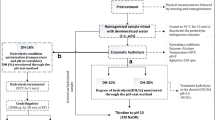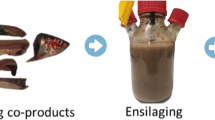Abstract
This study was focused on a by-product (i.e., belly muscle) resulting from the commercial processing of rainbow trout (Oncorhynchus mykiss). In it, n-3 long-chain polyunsaturated fatty acid (LCPUFA) concentrates were obtained from the belly oil by optimization of the urea-complexation process variables. Thus, the effect of urea:fatty acids (FA) ratio (0–6, w/w), crystallization temperature (− 30 to 30 °C), crystallization time (3.0–48.0 h) and stirring speed (0–1000 rpm) on the eicosapentaenoic acid (EPA, C20:5n-3) and docosahexaenoic acid (DHA, C22:6n-3) contents in concentrates was analyzed by response surface methodology. As a result, high values were obtained for total FA yield recovered, and contents on LCPUFA, EPA and DHA in the non-urea complexing fraction, as well as a great retention of saturated and monounsaturated FA in the urea-crystal adducts. After validation of the model obtained, the combination of process variables levels that maximizes the desirability function (0.91 score) for response variables was 4.21, ‒15 °C, 24 h and 1000 rpm, respectively. In agreement with the great significance and availability of farmed rainbow trout, belly muscle by-product confirmed to be a profitable source of n-3 LCPUFA to be commercialized as an added-value component.

Similar content being viewed by others
References
Uauy R, Valenzuela A (2000) Marine oils: the health benefits of n-3 fatty acids. Nutrition 16:680–684
Komprda T (2012) Eicosapentaenoic and docosahexaenoic acids as inflammation-modulating and lipid homeostasis influencing nutraceuticals: a review. J Funct Foods 4:25–38
Gbogouri G, Linder M, Fanni J, Parmentier M (2006) Analysis of lipids extracted from salmon (Salmo salar) heads by commercial proteolytic enzymes. Eur J Lipid Sci Technol 108:766–775
NolsØe H, Undeland I (2009) The acid and alkaline solubilization process for the isolation of muscle proteins: state of the art. Food Bioproc Technol 2:1–27
Zuta C, Simpson B, Man H, Phillips L (2003) Concentrating PUFA from mackerel processing waste. J Am Oil Chem Soc 80:933–936
Rubio-Rodríguez N, Beltrán S, Jaime I, M de Diego S, Sanz MT, Rovira J (2010) Production of omega-3 polyunsaturated fatty acid concentrates: a review. Innov Food Sci Emerg Tech 11:1–2
Fei C, Salimon J, Said M (2010) Optimisation of urea complexation by Box-Behnken design. Sains Malays 39:795–803
Wanasundara U, Shahidi F (1999) Concentration of omega 3-polyunsaturated fatty acids of seal blubber oil by urea complexation: optimization of reaction conditions. Food Chem 65:41–49
Liu S, Zhang C, Hong P, Ji H (2006) Concentration of docosahexaenoic acid (DHA) and eicosapentaenoic acid (EPA) of tuna oil by urea complexation: optimization of process parameters. J Food Eng 73:203–209
Falch E, Rustad T, Aursand M (2006) By-products from gadiform species as raw material for production of marine lipids as ingredients in food or feed. Proc Biochem 41:666–674
Blanco M, Sotelo C, Chapela MJ, Pérez-Martín R (2007) Towards sustainable and efficient use of fishery resources: present and future trends. Trends Food Sci Technol 18:29–36
Cheow C-S, Yu SY, Howell NK, Che Man Y, Muhammad K (1999) Effect of fish, starch and salt contents on the microstructure and expansion of fish crackers (“keropok”). J Sci Food Agric 79:879–885
Aidos I, Van der Padt A, Boom R, Luten J (2001) Upgrading of maatjes herring byproducts: production of crude oil. J Agric Food Chem 49:3697–3704
Haliloǧlu H, Bayır A, Sirkecioǧlu N, Aras M, Atamanalp M (2004) Comparison of fatty acid composition in some tissues of rainbow trout (Oncorhynchus mykiss) living in seawater and freshwater. Food Chem 86:55–59
Kolakowska A, Domiszewski Z, Kozlowski D, Gajowniczek M (2006) Effects of rainbow trout freshness on n-3 polyunsaturated fatty acids in fish offal. Eur J Lipid Sci Technol 108:723–729
Sone I, Nortvedt R (2009) A consumer preference study of raw Norwegian rainbow trout (Oncorhynchus mykiss) as sashimi with focus on young adults in Japan. Int J Food Sci Technol 44:2055–2061
Berríos MM, Rodríguez A, Rivera M, Pando ME, Valenzuela MA, Aubourg SP (2017) Optimisation of rancidity stability in long-chain PUFA concentrates obtained from a rainbow trout (Oncorhynchus mykiss) by-product. Int J Food Sci Technol 52:1463–1472
AOCS (1993) Official methods and recommended practices of the American Oil Chemists’ Society, 4th edn. AOCS Press, Champaign, IL
Pando ME, Bravo B, Berríos M, Galdames A, Rojas C, Romero N, Camilo C, Encina C, Rivera M, Rodríguez A, Aubourg SP (2014) Concentrating n-3 fatty acids from crude and refined commercial salmon oil. Czech J Food Sci 32:169–176
Guil-Guerrero J, Hassan E (2001) Purification process for cod liver oil polyunsatured fatty acids. J Am Oil Chem Soc 78:477–484
Myers R, Montgomery D, Anderson-Cook C (1995) Response surface methodology: process and product optimization using designed experiments, chap. 1. Wiley, New York, pp 1–11
CRC (1983) In: Rappoport Z (ed) Handbook of tables for organic compound identification, 11th printing, 3rd edn. CRC Press, Inc., Boca Raton, pp 466–467
Méndez C, Masson L, Jiménez P (2010) Estabilización de aceite de pescado por medio de antioxidantes naturales. Aceites y Grasas 80:492–500
MINSAL (2012) Reglamento Sanitario de los Alimentos. RSA. 1996. Dto. Nº 977/96 (D. OF.13.05.97). Modificado Dto. 83/09. Dpto. Asesoría Jurídica, Minsal D. OF. 25.06
IFOS (2014) The international fish oil standards program. http://www.nutrasource.ca/ifos/post/fish-oil-shelf-life--how-fresh-is-your-fish-oil/. Accessed 16 June 2016
GOED (2012) Global organization for EPA and DHA Omega-3. Voluntary monograph http://www.goedomega3.com/images/stories/files/goedmonograph.pdf./. Accessed 16 June 2016
CRN (2006) Council for responsible nutrition. Omega-3 voluntary monograph 2006. http://www.crnusa.org/pdfs/O3FINALMONOGRAPHdoc.pdf./. Accessed 16 June 2016
Rodríguez A, Castro E, Salinas MC, López R, Miranda M (2001) Interesterification of tallow and sunflower oil. J Am Oil Chem Soc 78:431–436
Haagsma H, Vangen C, Luten J, Jong R, Doorn V (1982) Preparation of an n-3 fatty acids concentrate from cod liver oil. J Am Oil Chem Soc 59:117–118
Acknowledgements
The work was supported by the FONDECYT-CONICYT (Fondo Nacional de Desarrollo Científico y Tecnológico-Comisión Nacional de Investigación Científica y Tecnológica) program throughout the Project No. 1120627.
Author information
Authors and Affiliations
Corresponding author
Ethics declarations
Conflict of interest
All Authors declares that they have no conflict of interest.
Human and animal rights statement
This article does not contain any studies with human or animal subjects.
Rights and permissions
About this article
Cite this article
Pando, M.E., Rodríguez, A., Galdames, A. et al. Maximization of the docosahexaenoic and eicosapentaenoic acids content in concentrates obtained from a by-product of rainbow trout (Oncorhynchus mykiss) processing. Eur Food Res Technol 244, 937–948 (2018). https://doi.org/10.1007/s00217-017-3013-0
Received:
Revised:
Accepted:
Published:
Issue Date:
DOI: https://doi.org/10.1007/s00217-017-3013-0




